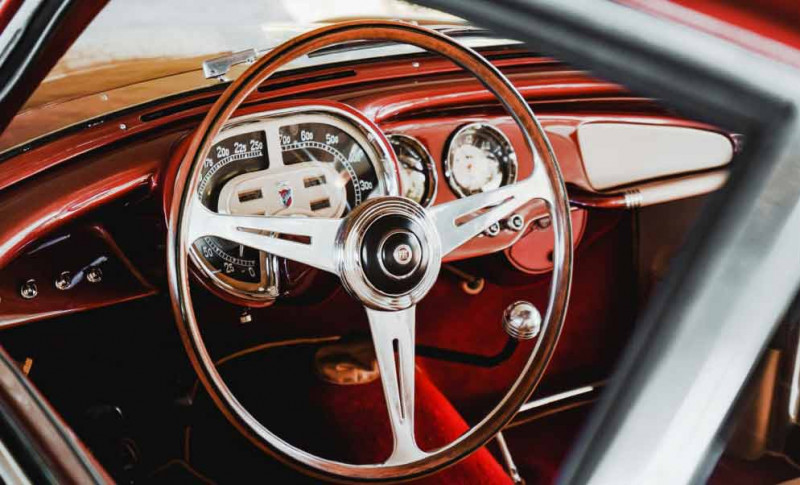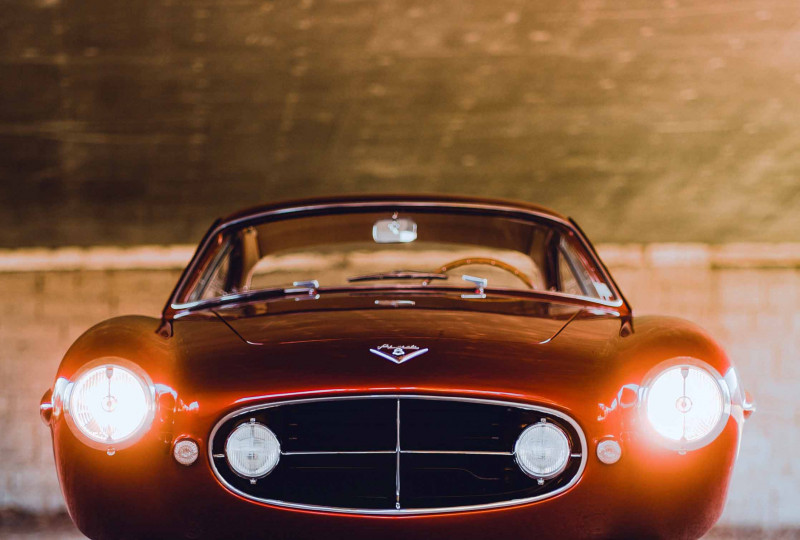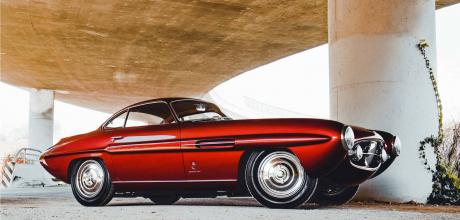1953 Fiat 8V Supersonic by Ghia
The impact of the Second World War could be felt across the globe. In the automotive sector, many factories were shut down or even destroyed. Quality materials used prior to WWII were in short supply and the day-to-day operations of once thriving companies were struggling across the board. Custom and small coachbuilders like Bertone, Pinin Farina (the company was renamed Pininfarina in 1961, when 68-year-old Battista ‘Pinin’ Pininfarina formally handed the business over to his son Sergio) and Ghia fell the hardest without the manufacturing support from the larger automobile factories, grappling to secure work and meaningful opportunities.
However, overseas manufacturers in the United States jumped at the opportunity to work with Italian coachbuilders. Enter Virgil Exner who was the current head of the design department at Chrysler and had a watchful eye on the work of these specialty craftsmen in the hopes of a collaborative venture. Ghia was approached by Chrysler, offering a Transatlantic styling partnership that gave Ghia steady cash and Chrysler the benefit of a European design and approach.

Meanwhile in Italy, Fiat had introduced the 8V chassis, which garnered attention from carrozzerias who wanted to design custom bodies to marry with this new platform.
Companies such as Zagato, Vignale and others bid to Fiat with ideas to attire this car, which would become limited production 8V models. Luigi Serge, who was then the Commercial Director of Ghia, was one of those trying to attract the attention of Fiat. Giovanni Savonuzzi, the company's new Technical Director, was his ace in the hole with a background in aeronautical design. Savonuzzi had started his career with Fiat and enhanced his reputation with the groundbreaking Cisitalia 202 (the first car to become a permanent exhibit in the New York Museum of Modern Art) and other successful racing coupes. He had a wonderful sense of form and influence seen over his storied career. Cues he took on the 8V could later be found on the VW Karmann Ghia VW, Volvo P1800, as well as on Fords and Chevrolets alike.

Savonuzzi's design for the Fiat 8V was contemporary and modern, based on a somewhat radically shaped two-door coupe. A graceful yet flashy figure it was, giving this relatively small car a larger than life presence. With aerospace characteristics it would be referred to as the ‘Supersonic’ and would later become known as the paradigm for ‘jet-age’ styling. During the fall of 1953, Luigi Serge travelled to Detroit to meet with Chrysler executives to pitch some of his ideas. Also present at the meeting was a gentleman by the name of Paul Farago, a designer and engineer who was extensively involved with Chrysler’s styling department.
They were impressed with the new designs and with full support from Exner, Farago placed the first order for a Ghia-bodied Fiat 8V Supersonic. Carrozzeria Ghia of Torino was contracted for approximately 30 to 40 of the 114 8V examples built, of which the most striking were the 15 bodied to Giovanni Savonuzzi’s stunning initial design. All 15 Supersonics had subtle detail differences. Production only lasted about two years but the car was a brilliant fashion statement which had made a virtue of commercial necessity. This was a compelling proposition: a high-powered sports car dressed in a light, bespoke Italian alloy body, sitting atop a Siata-fabricated chassis with four-wheel independent suspension. Under the bonnet sat a stout alloy V8 engine of advanced overheadvalve configuration. There was a four-speed manual gearbox. Successfully raced by gentleman drivers all over the world, this Fiat 8V and Supersonic models were iconic during a memorable period for automobiles.

Many special and one-off designs later, S/N 000040 was built for Lou J. Fageol, the son and heir of Fageol Motors Company, founded in 1916. Claude and Frank Fageol focused on motor trucks, farm tractors and a diverse range of cars out of their factory in Oakland, California. There were four Fageol brothers, each with his own vision for modern transportation from buses to luxury automobiles. Many of their endeavours were halted by the Great Depression, but expansions into tractor design, railway bus shuttles and the Twin Coach Company allowed their work to continue for years to come.
Like the rest of his family, Lou Fageol always had an eye for style and design. He was also known in the speedboat world, racing year round and even capturing the 1951 Gold Cup with his hydroplane dubbed the Slo-Mo-Shun V. Always pushing the envelope, Lou also built race cars that ran at Indianapolis and he even bought an unfinished Art Sparks custom car, intended for speed work on the salt flats. Although it never actually challenged the likes of a Mercedes Silver-Arrow or Auto Union by Sparks, Fageol completed the vision with one of his own twin Miller engines. This was dubbed the Fageol Supersonic.
There is no doubt of his power and influence with the industry’s biggest executives, including K.T. (Kaufman Thuma) Keller, President of the Chrysler Motor Company from 1935 to 1950 (and Chairman from 1950 to 1956). Almost as soon as a car was delivered, Fageol would rip off the bumpers and fit his own custom alternatives. These unique, split triple-finned chrome bumpers had featured on some of his earlier designs. He also gave the Supersonic twin Pepco superchargers to accompany quadruple Zenith carburetors – essentially boosting the brake horsepower by 30 and the top speed to around 140mph.

After Lou’s passing, the car made its way to Paul Ross Jr of Kent, Ohio, a family friend. Ross later moved to the suburbs of San Diego, California, where the car sat in poor condition from the late 1980s until 2001, when his son acquired it and installed a small block Chevy motor. It wasn’t discovered again until 2012 by the current owner. Being an 8V enthusiast, the native Belgian decided it was time for a full nut and bolt restoration. A painstaking task to prepare the car for a public display at concours around the world.
In 2015 it was displayed at the 65th annual Pebble Beach Concours d’Elegance, taking home an impressive first in class award. This car, S/N 000040, had last been displayed on a concours lawn exactly 60 years earlier – the same 18th fairway at Pebble Beach. The following year it received an honourable mention at the Concorso d’Eleganza Villa d’Este on the shores of Lake Como as well as the best restoration award at the Zoute Grand Prix Concours d’Elegance in Belgium. You might see a Supersonic at various events around the world, sitting static at the Pebble Beach Concours lawn, or around the shores of Lake Como. They even pop up once in a while at a major auction house like Bonhams, RM or Gooding and Company. But to see one in motion – in flight – really is a special sight. It commands your attention, your respect and your acceptance.
WITH AEROSPACE CHARACTERISTICS IT WOULD BE REFERRED TO AS THE 'SUPERSONIC'
ABOVE: This example is equipped with twin Pepco superchargers as well as four Zenith carburettors.
SUCCESSFULLY RACED BY GENTLEMAN DRIVERS ALL OVER THE WORLD, THIS FIAT 8V AND SUPERSONIC MODELS WERE ICONIC DURING A MEMORABLE PERIOD FOR AUTOMOBILES
SAVONUZZI'S DESIGN FOR THE FIAT 8V WAS CONTEMPORARY AND MODERN, UTILISING A TWO-DOOR COUPE BASE THAT WAS SOMEWHAT RADICAL IN SHAPE
LEFT: Battista ‘Pinin’ Farina (the surname change to Pininfarina came later) rewrote
the bonnet. This technique is used beautifully on this most special Fiat, suggesting a new optimism for postwar Europe: the automotive world embodies such dreams!
RIGHT: Unmistakable Fiat character shines through in the 8V. Note, for example, the lovely painted dashboard. Mass-produced Fiats from the 103-series 1100, through the 1800 and 1500 all almost certainly by Nardi.


